By Brian G Carlson for Center for Security Studies (CSS)
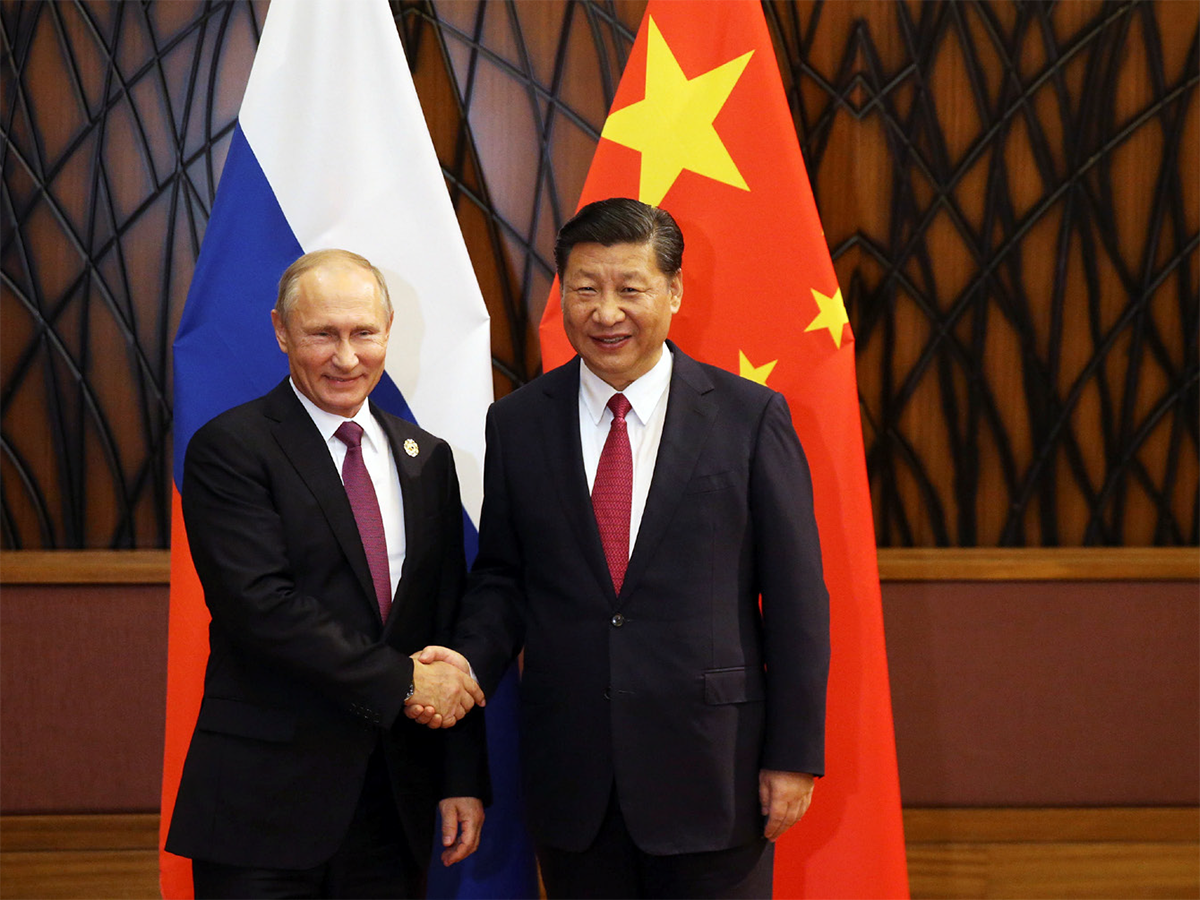 Brian Carlson believes that for both the US and Europe, the extent of China-Russia coordination deserves close watching. As a result, Carlson here explores 1) China-Russia bilateral ties, particularly in terms of economics, energy and arms; 2) the two countries’ ‘friendly neutrality’ regarding the other’s regional affairs; and 3) how China-Russia relations have been gaining momentum at the global level. He also highlights how shared concerns about US power and resistance to liberal norms provide a strong basis for a continued close relationship, albeit one increasingly tilted in China’s favor.
Brian Carlson believes that for both the US and Europe, the extent of China-Russia coordination deserves close watching. As a result, Carlson here explores 1) China-Russia bilateral ties, particularly in terms of economics, energy and arms; 2) the two countries’ ‘friendly neutrality’ regarding the other’s regional affairs; and 3) how China-Russia relations have been gaining momentum at the global level. He also highlights how shared concerns about US power and resistance to liberal norms provide a strong basis for a continued close relationship, albeit one increasingly tilted in China’s favor.
This article was originally published in Strategic Trends 2018 by the Center for Security Studies on 13 April 2018.
At a time of turmoil in the West, China and Russia pose growing challenges to the liberal international order. The China-Russia relationship has grown stronger in recent years, as the two countries have increased coordination on North Korea and other issues. China and Russia are not about to form an alliance, but neither are they likely to drift apart in the near future. Their shared concerns about US power and resistance to liberal norms provide a strong basis for a continued close relationship, albeit one increasingly tilted in China’s favor.
As US President Donald J. Trump’s first year in office drew to a close, his administration increasingly pointed to the national security challenges posed by China and Russia. The new National Security Strategy of the United States, issued in December 2017, named China and Russia as “revisionist powers” that “challenge American power, influence, and interests, attempting to erode American security and prosperity.”1 The summary of the 2018 National Defense Strategy, unveiled in January 2018, identified the “central challenge to U.S. prosperity and security as the reemergence of long-term, strategic competition” by these revisionist powers.2
These policy declarations represented a shift from one year earlier, when Trump entered office amid speculation that he would pursue a rapprochement with Russia. One of the purported goals of such a policy was to wrest Russia away from China’s embrace, using a strengthened US-Russia relationship as leverage over China. Such an attempt at triangular diplomacy would have been straight out of the playbook of former secretary of state Henry Kissinger, with the roles of Moscow and Beijing reversed this time.3
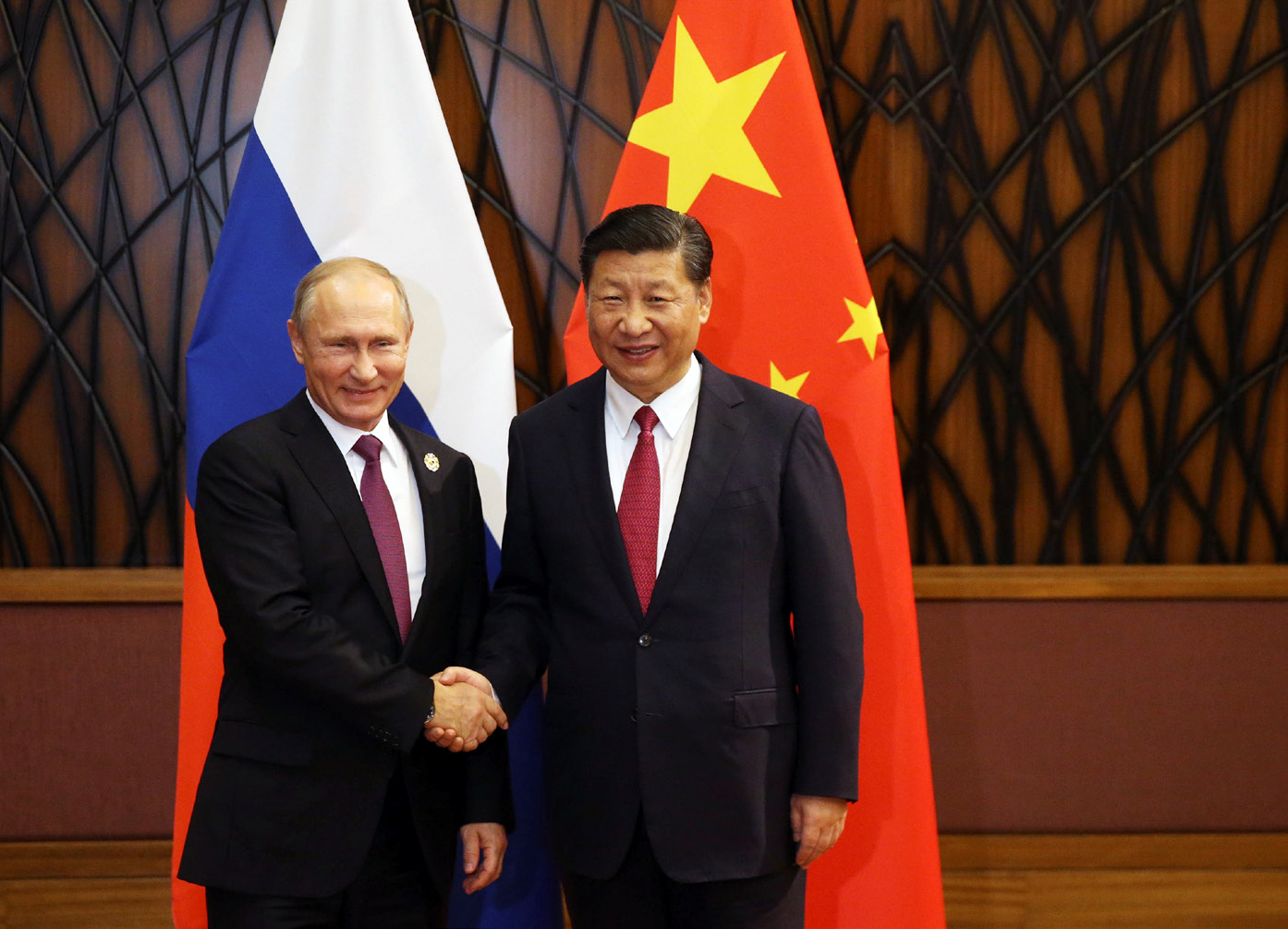
Russian President Vladimir Putin and Chinese President Xi Jinping shake hands during a meeting in Danang, Vietnam, 10 November 2017. Sputnik, Konstantin; Zavrazhin, Kremlin / Reuters
Bipartisan domestic opposition, based partly on concerns about Russia’s interference in the 2016 presidential election, hindered Trump’s ability to conduct diplomatic outreach toward Russia. Regardless of domestic political constraints, however, attempts to pry Russia away from China were never likely to succeed. The Cold War context that gave rise to Kissinger’s strategy is long gone. Russian leaders, having absorbed the painful lessons of the Sino-Soviet split, recognize that their country’s security and prosperity depend on maintaining friendly relations with their increasingly powerful neighbor, regardless of the state of relations with the US. For its part, China needs friendly relations with Russia in order to assure itself of a “strategic rear” to the north, given its tense relations with several other neighboring countries. Moreover, the common positions that China and Russia hold on many international issues, including their discomfort with US power, objections to an international order reflecting liberal norms and values, and shared desire to resist perceived threats to their forms of domestic governance, provide ample reason for them to maintain close relations.
As Jack Thompson argues in this volume, a series of factors both foreign and domestic are placing US foreign policy under stress. In the coming years, the challenge that China and Russia pose to the liberal international order will be one such factor. For both the US and Europe, the extent of coordination between China and Russia deserves close watching. In recent years, this coordination has grown stronger. A think tank report published in 2016, co-authored by Russian and Chinese experts, argued that “Russia-China rapprochement in security is special in that the two countries have come close to the line that distinguishes partnership from a military and political alliance,” though neither state wished to cross this line.4 That same year, in an article aimed at Western audiences, a former vice foreign minister of China argued that the two countries, despite having no intention to form an alliance, nevertheless shared sufficiently close interests and values to ensure that their partnership would remain durable.5
China and Russia have gradually strengthened their relationship over the past quarter-century. Vladimir Putin’s return to the Russian presidency in 2012 and Xi Jinping’s accession to power in China that same year were important stimulants to the bilateral relationship. The onset of the Ukraine crisis strengthened relations further by driving Russia into China’s arms. Facing Western sanctions for its annexation of Crimea and its support for insurgents in eastern Ukraine, Russia sought both an economic lifeline and a diplomatic partner to reduce its isolation. China was the obvious candidate. Subsequent developments, including the continued stalemate in Ukraine, Russia’s intervention in the Syrian civil war, and allegations of Russian meddling in US and European elections have ensured continued friction in relations between Russia and the West. China, meanwhile, perceives growing pressure from the US as its rise to power gathers force. These tensions, in turn, lay the groundwork for sustained cooperation between China and Russia.
The growing strength of the China- Russia relationship has belied the expectations of many Western analysts. The two countries remain unlikely to form an alliance, partly because neither wishes to be dragged into the other’s regional conflicts. Moreover, the balance of power within the relationship is shifting rapidly in China’s favor, which could eventually become a major concern for Russia. To date, however, the two countries have set aside their differences in order to pursue common interests. Their “strategic partnership”, though subject to limitations, is not likely to break down in the near future. Under this arrangement, which is looser than an alliance, the two countries offer each other a measure of diplomatic support on a range of issues and at least “friendly neutrality” in each other’s regional disputes. In 2018 and beyond, the China-Russia relationship will continue to exert significant influence on issues of international concern, unfolding at the bilateral, regional, and global levels.
The Bilateral Level: Economics, Energy, and Arms
In the face of Western sanctions following the onset of the Ukraine crisis, Russia attempted a pivot to China in order to compensate, at least partially, for the resulting economic losses. The chief result, however, was that China increased its bargaining leverage in the two strongest sectors of the bilateral economic relationship, namely energy and arms sales. In both sectors, negotiations on important deals had begun before the Ukraine crisis but had failed to reach conclusion. After the outbreak of the crisis, the two countries achieved important breakthroughs in these negotiations, with results that were especially advantageous for China.
The benefits that Russia hoped to achieve from its economic outreach to China have been slow to materialize. This should not have been surprising, considering that bilateral economic ties have been a weak link in the China-Russia relationship throughout the post-Soviet era. The volume of bilateral trade consistently pales in comparison to China-US, China-EU, and Russia-EU bilateral trade volumes. Russia has also relied primarily on Western financial markets for access to credit.
In 2014, the year that the West began to impose sanctions, the volume of China-Russia bilateral trade reached an all-time high of 95 billion USD. However, this figure fell to 68 billion USD in 2015, largely because of a sharp drop in energy prices.6 The trade volume remained flat in 2016 and remains well short of the 2014 peak. Some Russian critics concluded that Russia’s attempted pivot to Asia, which in practice focused heavily on China, had been largely a failure in economic terms.7 The most significant results of bilateral economic diplomacy have been major agreements on natural gas and weapons sales.
During Putin’s visit to China in May 2014, China and Russia struck a 400 billion USD gas supply deal, with Russia’s Gazprom agreeing to supply the China National Petroleum Corporation (CNPC) with up to 38 billion cubic meters of gas per year for 30 years, starting in 2018. Analysts estimated that the price China would pay for the gas, which was not disclosed publicly, would be comparable to the price that European customers were paying for supplies from Gazprom.8 Initially, Gazprom expected that China would invest 25 billion USD in the construction of the pipeline, known as Power of Siberia. However, this arrangement fell apart, and Gazprom is now financing the pipeline’s construction by itself. In July 2017, CNPC announced that it would receive the first supplies from the Power of Siberia pipeline in December 2019, about one year behind schedule.9
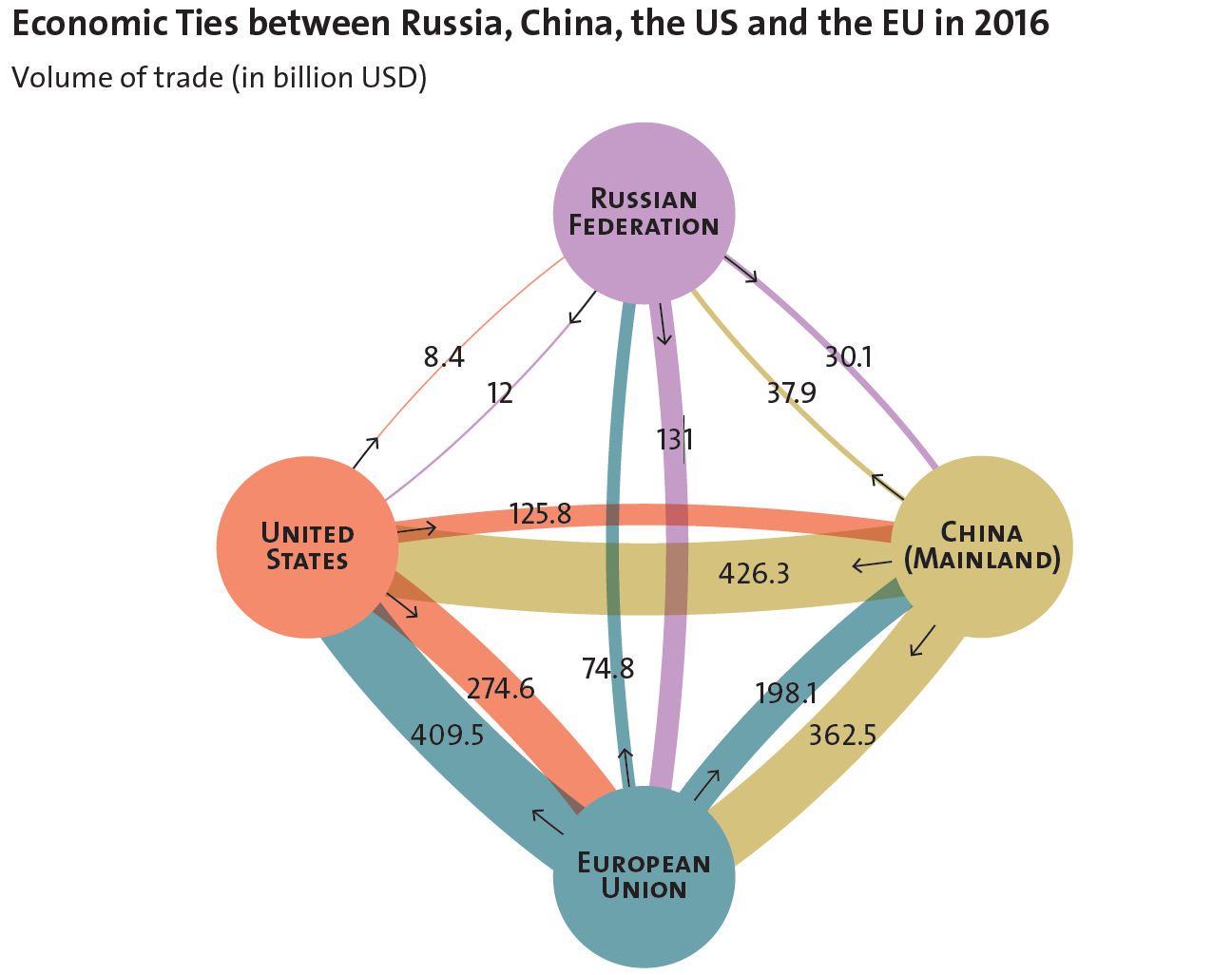
Note: When a disparity existed between data reporting the same movement of trade in a different way – for example, US exports to China versus Chinese imports from the US – this graphic uses the average of the two figures. Source: IMF Data, Direction of Trade Statistics (DOTS)
The gas deal allowed Putin to demonstrate that Russia enjoyed alternative economic and diplomatic options in the face of Western sanctions. However, the terms of the negotiations largely favored China. The gas supplies for the Power of Siberia pipeline will come from fields in Eastern Siberia, which Russia can supply only to Asian countries because they remain unconnected by pipeline to European markets. The western Altai route remains Russia’s preferred option for a gas pipeline to China. This proposed pipeline, which would pass through the two countries’ short western border between Kazakhstan and Mongolia, would draw its supplies from gas fields in Western Siberia that are already connected by pipeline to Europe. Under this option, Russia would be able to play China off against its European customers, thereby gaining bargaining leverage. China has expressed little interest in the Altai pipeline, however, largely because it has a multitude of other options for gas supply, including imports of gas by pipeline from Central Asia and of liquefied natural gas (LNG) from a variety of suppliers.10
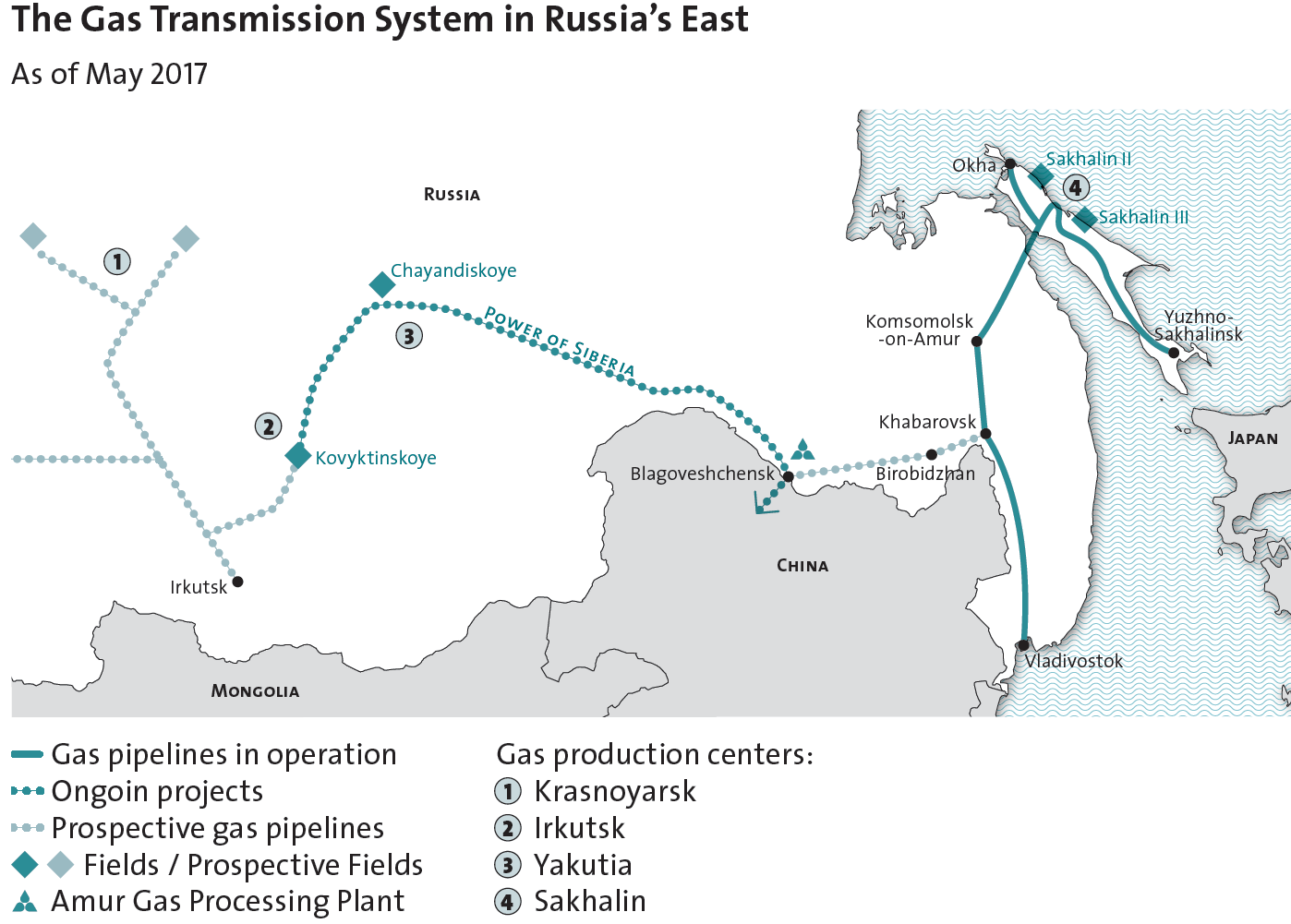
Source: PJSC Gazprom (18.5.2017)
As a result, Russia has assumed the financial burden for Power of Siberia, an expensive project, without gaining much ability to play the “China card” in gas negotiations with Europe.
Chinese investors also gained opportunities to invest in Russia’s energy sector, a sphere in which they had long faced restrictions. China’s Silk Road Fund, which was established to finance projects that are part of the Belt and Road Initiative, purchased a 9.9 per cent stake in the Yamal LNG project.11 The Silk Road Fund also purchased a 10 per cent stake in Sibur, Russia’s largest petrochemicals group, whose investors include Gennady Timchenko, a friend of Putin’s who is under Western sanctions.12 In September 2017, the Chinese energy conglomerate CEFC purchased a stake of more than 14 per cent in Rosneft, Russia’s largest oil company, from Glencore and the Qatar Investment Authority, which had acquired a 19.5 per cent stake in the company less than one year earlier. The purpose of the Rosneft deals, apparently, was to close holes in Russia’s state budget.13 The Chinese company’s acquisition of this stake in Rosneft suggested, however, that the balance of power in the energy relationship was tilting further in China’s favor.14
In early 2018, rising oil prices offered hope for the Russian economy. The collapse in oil prices that began in 2014, in combination with Western sanctions, struck a heavy blow to the Russian economy and to the government’s budget. With oil prices once again rising, however, Goldman Sachs projected 3.3 per cent economic growth for Russia this year.15 Russia also edged out Saudi Arabia as China’s leading oil supplier for the second consecutive year in 2017, accounting for more than 14 per cent of China’s oil imports.16 For China, Russia serves as an important source of diversity of supply. As with deliveries from Central Asia, oil supplies from Russia arrive in China through an overland pipeline, reducing China’s vulnerability to naval blockade in a potential conflict with the US.
China also seized opportunities to gain access to advanced Russian weaponry. Although Russia has been China’s largest foreign arms supplier throughout the post-Cold War era, Russian officials were reluctant for many years to supply China with their most sophisticated weapons technology. From the mid-2000s until recent years, Russian arms sales to China contracted sharply. Russian officials had grown frustrated with Chinese copying of their weapons technology, while China focused on domestic production. Starting around 2012, China once again turned to Russia for military technology, first aircraft engines and later advanced weaponry that would enhance its anti-access/ area denial capabilities in the Asia- Pacific region. Following the onset of the Ukraine crisis, China succeeded in purchasing top-flight Russian weapons for this purpose. The two most important purchases were the S-400 air defense system and 24 Su- 35 fighter jets.
The S-400 system of anti-aircraft missiles can strike aircraft, unmanned aerial vehicles (UAVs), and cruise missiles at a range of up to 380 kilometers. China plans to deploy the system along its coastline, giving the PLA the capability to contest significant amounts of the airspace near Taiwan and the Paracel and Senkaku Islands, all of which the US could be called upon to defend in a crisis. The Su-35 fighter jets enjoy advantages in range and maneuverability over China’s existing fighter force. These Russian arms sales to China, therefore, significantly complicate the US military’s task of defending its allies and providing security in the Asia-Pacific region.17
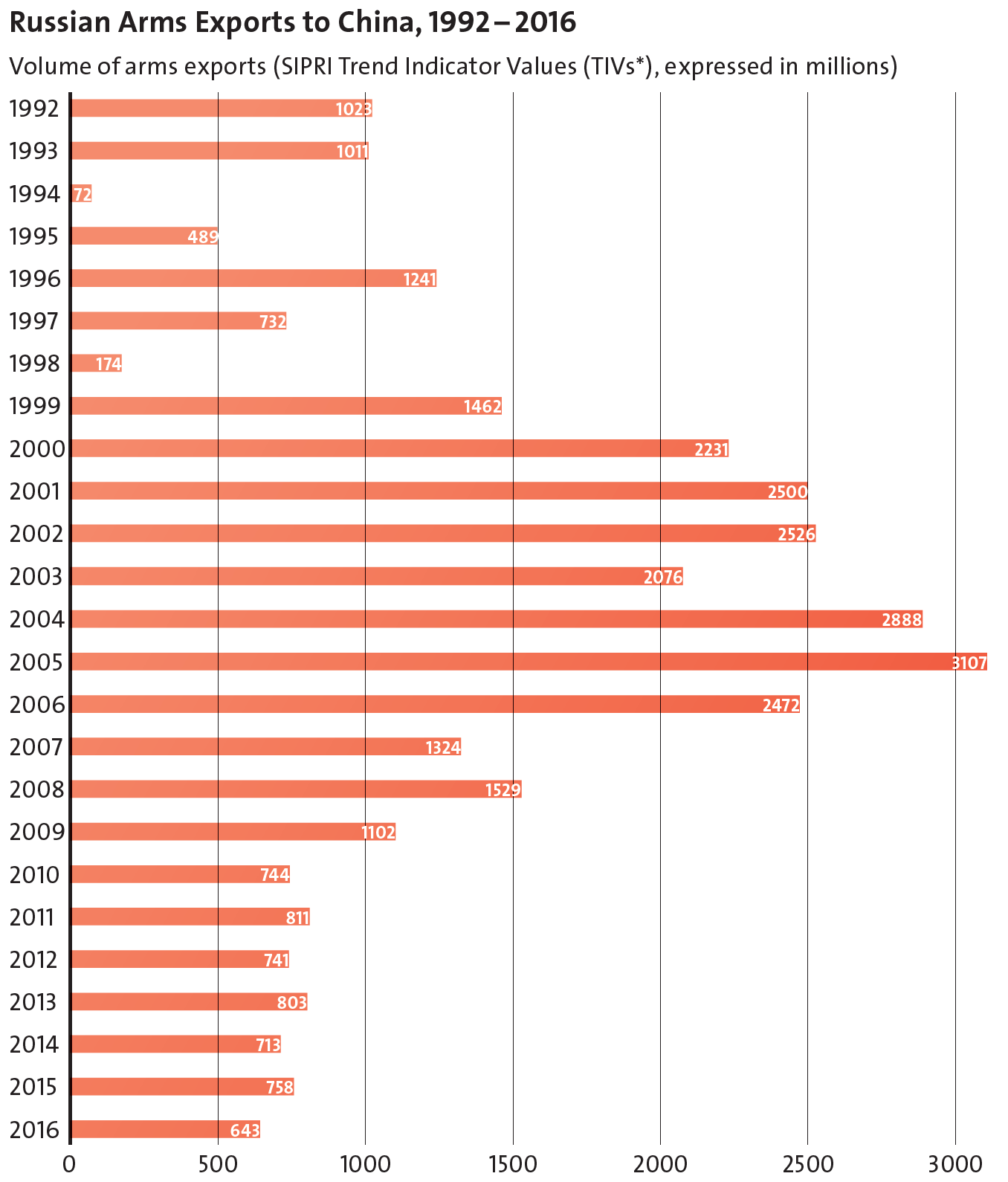
* “SIPRI statistical data on arms transfers relates to actual deliveries of major conventional weapons. […] The TIV is based on the known unit production costs of a core set of weapons and is intended to represent the transfer of military resources rather than the financial value of the transfer” (see SIPRI Arms Transfers Database – Methodology). Note: Recent sales are projected to increase volumes of export deliveries back to levels approaching the peak of the mid-2000s.
Source: SIPRI Arms Transfers Database
For China, these sales represented an opportunity to gain access to systems in which Russia maintains a technological edge. Russia’s decision to sell these advanced systems to China, on the other hand, was informed by a series of considerations. The sales offer an opportunity to strengthen political and military relations with China, which Russia views as a crucial partner at a time of strained relations with the West. Russia had already completed research and development on these weapons systems, and sales to China offered an opportunity to maximize profits from existing technologies. Russian officials believed that China was likely to gain access to these technologies in any case, so Russia might as well earn revenues from their sale. Russia remained concerned about the possibility of Chinese copying of Russian designs, but the length of time needed for such efforts partly assuaged these worries. For example, Russia calculated that by the time China succeeded in producing its own version of the S-400, Russia’s defense sector would already have produced the next-generation air defense system, the S-500.18
The major weapons systems that Russia has sold to China recently are well suited for maritime contingencies, not for a potential land invasion of Russia. By strengthening China’s military capabilities in a potential conflict with the US and its allies in the Asia-Pacific region, Russia diverts US strategic focus toward Asia and away from Europe. In this way, these Russian arms sales complicate European security policies. With US resources and strategic attention increasingly stretched thin, NATO’s European members might face increased pressure, in the coming years, to increase their own military spending and contributions to European security.
The Regional Level: Spheres of Influence
The challenges that China and Russia pose to the international order take shape primarily at the regional level. Although both countries are seeking to increase their influence on the international stage, with China’s capabilities in this respect rising rapidly, they have the greatest capacity to pursue their respective goals close to home. Both countries are effectively seeking spheres of influence in their respective regions – Russia in the post-Soviet territories, and China in the Asia-Pacific. Both countries have engaged in “probing” to test the limits of US power and commitment to regional allies.19
Neither country fully supports the other’s regional objectives, which is one reason why they are unlikely to form an alliance. For example, China expressed measured support for Russia’s war in Georgia in 2008, but declined to join Russia in recognizing the sovereignty of two breakaway regions from that country. Similarly, China sympathized with Russia’s view that the West had fomented the revolution in Ukraine and that further expansion of Euro-Atlantic institutions to the east was unacceptable. Yet China could not support Russia’s annexation of Crimea because it violated core principles of Chinese foreign policy, including support for state sovereignty and territorial integrity. Russia, in turn, remains officially neutral on China’s maritime disputes in the South China Sea and the East China Sea. In essence, both countries observe a “friendly neutrality” regarding the other’s regional affairs.20 This arrangement enhances both countries’ strategic room for maneuver.
Central Asia is one region in which the interests of China and Russia could clash. Russia still regards the region as its backyard, but China’s regional influence has grown rapidly. Xi Jinping’s announcement in September 2013 of China’s plans for the Silk Road Economic Belt, which later became one component of the Belt and Road Initiative, heightened Russia’s concerns. China’s plans to finance infrastructure projects through Central Asia and onward to Europe and the Middle East threatened to marginalize Russia further in the region. To date, however, China and Russia have avoided a clash in Central Asia and have sought to reach an accommodation. Symbolic of these efforts was a May 2015 bilateral agreement to link up the Silk Road Economic Belt with the Eurasian Economic Union, the Russian-led regional integration project. Although the fulfillment of this aspiration will require concrete projects, a prospect that remains uncertain, this agreement expressed the two countries’ political desire to accommodate each other’s regional interests.
Several factors help to explain efforts by China and Russia to achieve cooperation in Central Asia. For Russia, ceding regional influence to China is undesirable, but also virtually unavoidable. Russia lacks the economic and financial weight to compete with China in promoting regional economic development. The Ukraine crisis, which erupted just a few months after Xi announced his initiative, caused a sharp downturn in Russia’s relations with the West, underscoring China’s importance in Russia’s foreign policy. Russia was unwilling to risk a rupture in this crucial relationship by aggressively challenging China’s growing presence in Central Asia.
For its part, China recognized that its ambitious Silk Road plans would be far more likely to succeed with Russia’s support than in the face of Russian opposition. China sought to reassure Russia by emphasizing that its goal was to promote regional economic development, not to strengthen its political influence or security presence in the region. Some analysts, particularly on the Russian side, have proposed a “division of labor” in which China would serve as the primary engine of regional economic development, while Russia would maintain its role as the region’s main security provider. The long-term prospects for such an arrangement remain uncertain, however. China’s growing economic influence in the region will inevitably lead to increased political influence, and the need to protect its investments in the region may eventually lead China to consider expanding its security presence there as well.
In the face of China’s relentless expansion of influence in Central Asia, Russia has sought to make the best of the situation by encouraging China to invest in infrastructure projects in Russia. One concern among Russian policymakers and analysts is that the Belt and Road Initiative could end up largely bypassing Russia, focusing instead on Central Asian infrastructure projects and port facilities in Europe. Russia hopes to entice Chinese investment in a transport corridor passing through Russian territory and onward to Europe. At a time when China is investing in infrastructure projects in multiple directions, Russia also hopes to attract China’s interest in the Russian Far East. Russian scholars have proposed linking centers of production in China’s Northeast by rail to ports in the Russian Far East, which are in many cases closer than China’s own ports. Russian leaders also hope that China’s interest in Arctic Sea shipping will generate investment in Russian port facilities along this route, though they will balance this desire against concerns about China’s expanding influence in the Arctic.21
In the Asia-Pacific region, the interests of China and Russia do not fully coincide. China is an emerging superpower that aims to gain primacy in Asia, while Russia’s influence in the region has dwindled. Russia would prefer to maintain a diverse portfolio of relationships in Asia, rather than risk becoming overly dependent on China. Partly for this reason, Russia has resisted China’s calls to form a united front in their respective territorial disputes with Japan and to offer increased support for China’s positions on other maritime disputes. In the period leading up to the Ukraine crisis, Russia and Japan energized bilateral diplomacy with the goal of resolving their dispute over the Kuril Islands. Just as Russia sought balance in its Asian diplomacy, Japan sought to improve relations with Russia as a hedge against the rise of China. These talks broke down when Japan joined Western sanctions against Russia, and efforts to revive them have been unsuccessful. Russia’s close relations with Vietnam, which is involved in maritime territorial disputes with China in the South China Sea, also cause tension in China-Russia relations.
Although Russia officially maintains neutrality on China’s territorial disputes in the South China Sea, it appears to have edged closer to China’s position. In July 2016, the Permanent Court of Arbitration in The Hague ruled that China’s sweeping claims to control over waters encompassing around 90 per cent of the South China Sea were in violation of the UN Convention on the Law of the Sea (UNCLOS), of which China was a signatory. China rejected the court’s ruling, which had no means of enforcement, and vowed not to abide by it. A few weeks later, while attending the G-20 conference in Hangzhou, China, Putin declared his support for China’s rejection of the ruling. He also backed China’s position that outside powers such as the US should stay out of these disputes. That same month, Russia and China held joint naval exercises in the South China Sea. Through these exercises, China appeared determined to signal both its defiance of the court’s ruling and its ability to turn to Russia for diplomatic support.
In regions such as Central Asia and the Asia-Pacific, as in bilateral relations, the growing imbalance of power in China’s favor has pushed Russia to adopt positions that are increasingly favorable to China. This trend is also visible at the global level.
The Global Level: An Increasingly Close Partnership
China-Russia relations have gained momentum at the global level, particularly since the onset of the Ukraine crisis. This has been especially apparent in the two countries’ handling of the North Korean nuclear crisis, as they have maintained solidarity in opposing most forms of US pressure on the regime in Pyongyang. The two countries stood together in opposing the deployment of the Terminal High Altitude Area Defense (THAAD) system in South Korea, insisting that this system would threaten their own nuclear deterrent capabilities. In 2017, as the crisis over North Korea’s nuclear program intensified, China and Russia issued a joint declaration calling for a “dual freeze” in which North Korea would cease conducting nuclear and missile tests in return for a suspension of joint military exercises by the US and South Korea. During the fall of 2017, they worked together in the UN Security Council to water down proposed sanctions on the North Korean regime, most importantly by opposing an oil embargo. China and Russia demonstrated that they would make serious efforts to restrain the North Korean regime only in exchange for strategic concessions that would reduce the US political and security presence in Northeast Asia.22
In Northeast Asia, Russia has deferred to China’s leadership. In the Middle East, by contrast, China has been content to let Russia play a leading role. Russia is sure to be outspoken in opposing efforts by the Trump administration to renegotiate or discard the nuclear deal with Iran, an issue on which it can count on China’s support. In this case, Russia and China are likely to find considerable support for their position among European countries as well. On issues concerning the Middle East more broadly, China’s inclination is to remain above the fray. For example, China attempts to maintain a balance in its relations with Iran and Saudi Arabia, hoping to enjoy the economic benefits of relations with both of these rivals. China is largely content to stand aside as Russia pursues its own interests in Syria and elsewhere in the region.
China and Russia are likely to maintain solidarity on several other international issues as well. Both countries oppose US plans for missile defense, asserting that such plans could erode their nuclear deterrent capabilities. In December 2017, for the second time, the two countries conducted a joint, computer-simulated missile defense exercise. China and Russia also hold similar views on issues relating to cyberspace, often in ways that clash with Western notions. In particular, they support the right of governments to exert considerable control in this domain as a natural extension of state sovereignty.23 At the same time, both countries appear to be stepping up efforts to use a variety of methods, including social media, to increase their influence in Western countries, in some cases seeking to foment chaos within these societies and undermine confidence in democracy. Western countries will continue to be alert to threats from this kind of “sharp power”.24
As this overview demonstrates, China and Russia have expanded their cooperation across a range of issues. The prospect of a geopolitically significant China-Russia bloc, possibly even a quasi-alliance involving close political coordination, seems more plausible than it did even a few years ago. Some prominent analysts in China have called for an alliance with Russia, calling this an essential step for resisting US strategic pressure as their country continues to rise.25 However, this remains a minority view among Chinese leaders and strategists. In both China and Russia, the political consensus holds that an alliance would unduly restrict diplomatic flexibility and incur unnecessary risk. The leadership in both countries views the current, looser arrangement as the best way to maximize the value of the bilateral relationship.
Although the strategic partnership has grown increasingly close, Russia continues to harbor long-term concerns. China’s growing advantage in what its strategists call “comprehensive national power” could eventually cause Russian leaders to reevaluate their strategic priorities, possibly in ways that would undermine the relationship. Although concerns about Chinese immigration to the Russian Far East have subsided since the 1990s, a glaring demographic imbalance still exists between Russia’s sparsely populated, underdeveloped eastern regions and China’s populous bordering regions. Russian leaders worry that China eventually could dominate the Russian Far East economically. Russia’s strategy to resist a threatened Chinese invasion of Russian territory, admittedly a scenario that Russian strategists consider extremely unlikely, appears to rely ultimately on nuclear deterrence, based partly on the threat to use tactical nuclear weapons in the early stages of a conflict. In the view of many analysts, a major driving force behind Russia’s alleged violations of the Intermediate- Range Nuclear Forces (INF) Treaty is the desire of Russian military planners to establish an effective counter to China’s growing arsenal of missiles, many of which are of the intermediate ranges prohibited by the treaty.26
Despite such lingering concerns, the two countries have formed a close partnership that is likely to prove resilient for the immediate future. The last quarter-century of interactions has revealed some inherent limitations in the China-Russia relationship, but this partnership has also proven more resilient than many predicted. Similarities in the two countries’ national identities, especially their discomfort with US primacy, opposition to an international order dominated by liberal values, and sensitivity to criticism of their own domestic governance and human rights records, are crucial factors.27 Some Russian analysts, while acknowledging that the initial economic benefits of Russia’s pivot to China had been disappointing, nevertheless argued that a convergence of political interests, not economics, provided the essential foundation for the China-Russia relationship.28
The current arrangement offers both China and Russia some strategic room for maneuver, but China is the main beneficiary. A report by US analysts in 2017 argued that the US position in the “strategic triangle” had deteriorated because of tension in US relations with both China and Russia, allowing China to occupy the “hinge”.29 This advantageous position gives a further boost to the rise of China, which already poses a major challenge to US foreign policy. The rise of China, in turn, will divert US attention to Asia, heightening the challenges of ensuring European security.
No comments:
Post a Comment